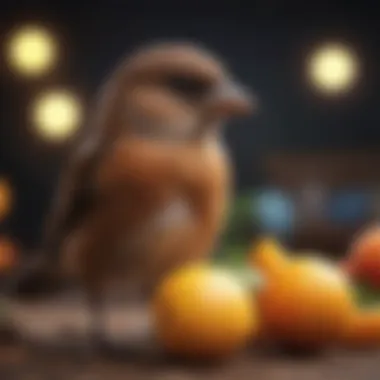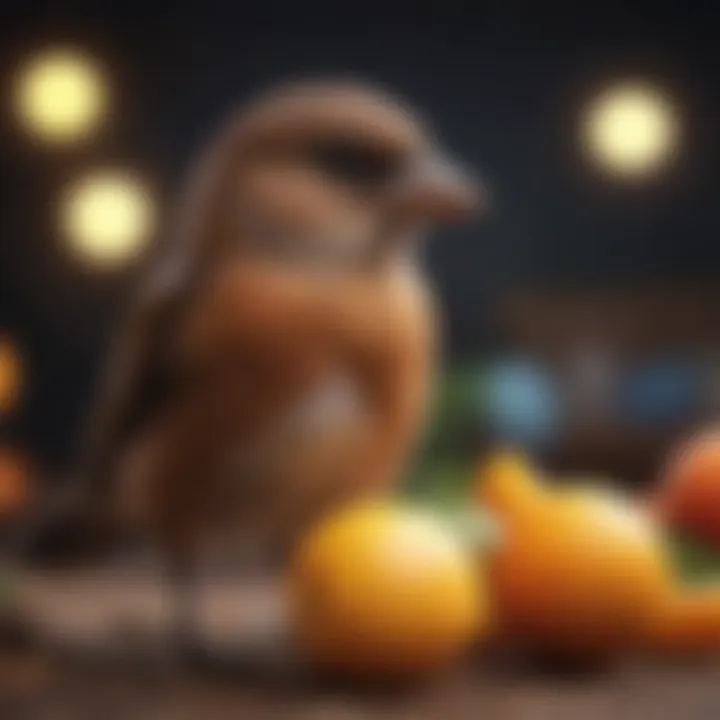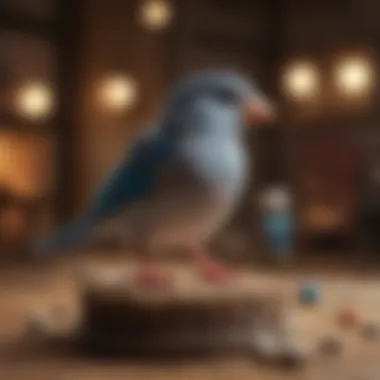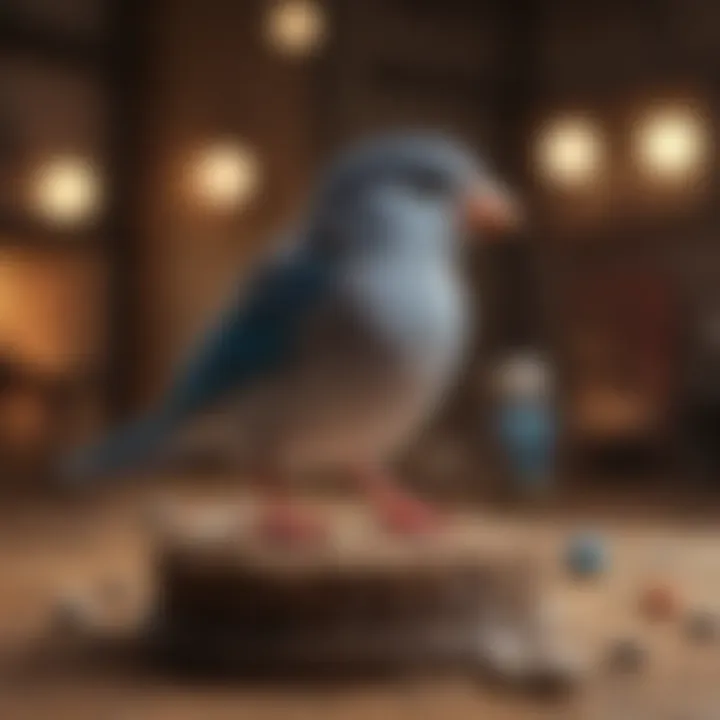Discovering Small Pet Bird Breeds: A Detailed Guide


Intro
The charm of small pet birds captivates many, bringing joy and color to our lives. With a whole roster of diligent little creatures, we can often find ourselves at a crossroads when choosing the right one as a feathered companion. This comprehensive guide aims to peel back the layers of various small bird breeds, providing a wealth of information that can help prospective bird parents navigate their options. Whether you're new to the avian world or looking to expand your flock, understanding the specific traits and needs of these charming pets is vital.
Birds, like other pets, require not just warmth and food, but also meticulous attention and care, something that determines how well they adapt to their new settings. From development to personality traits, everything falls under scrutiny and can greatly impact the bond one forms with their avian companion.
Here, we’ll cover the essentials for both novice and seasoned bird lovers, including their daily routines, housing, social habits, and dietary needs. We want to foster relationships, ensuring diligent bird owners are equipped with the tools necessary to create an enriching environment for their feathered friends.
The exploration of care, behavior, nutrition, wellness, and activities will unfold slowly, revealing intricate details that illustrate the unique needs and joys of living with small pet birds. This is not just about choosing a pet; it's about understanding their world and enhancing the bond you share.
"Owning a bird is a shared journey between feathered friends and their human companions, involving communication, understanding, and care."
Let's begin our deep dive into the world of small pet birds with the very core of their well-being: care tips.
Prelude to Small Pet Birds
In the realm of pet companionship, small bird species often get the short end of the stick. Many people opt for dogs or cats, overlooking the wonder of keeping small pet birds. This article intends to shed light on these delightful creatures, aiming to arm potential owners with knowledge about their behaviors, needs, and advantages of keeping them as companions.
Small pet birds are not just charming with their bright feathers and melodious songs, they also offer unique personalities. Understanding the nuances of these birds can significantly enhance the ownership experience. They can be social and interactive, creating bonds that rival that of more traditional pets.
By exploring small pet birds, readers will gain insights about their care essentials and lifestyles. From feeding habits to socialization needs, keeping small pet birds requires a good amount of understanding, making the right choice for both the birds and their owners a crucial decision.
Defining Small Pet Birds
Small pet birds typically encompass a variety of species that are smaller in stature and are commonly kept as pets. This includes species like budgerigars, cockatiels, lovebirds, and several types of canaries. They can be distinguished by their vibrant plumage, small sizes, and captivating behaviors.
These birds generally weigh less than a pound and have a wingspan that allows them to flutter about comfortably in a home setting. Not only do they need less space compared to larger birds or animals, but they also often require less maintenance, making them an appealing choice for many aspiring pet owners.
Moreover, their compact size and engaging nature make them suitable for individuals living in smaller spaces, such as apartments. However, despite their small size, they require proper commitments to their health and environment, which is vital for nurturing any pet.
Reasons to Keep Small Pet Birds
There are a myriad of reasons to consider introducing a small pet bird into your home, appealing to diverse groups of people:
- Affordability: Generally, small pet birds are less expensive to acquire and maintain than larger pets. The initial purchase price typically includes the bird, a suitable cage, food, and necessary toys.
- Social Interaction: Many small birds are known for their sociable nature. They can mimic sounds, play games, and even build strong bonds with their owners. This can provide a heartwarming experience for individuals craving companionship without the commitment of larger animals.
- Low Maintenance: Compared to dogs or cats, small birds can be less demanding in terms of daily care routines. Basic needs, such as food and social interaction, can be managed with less time and effort.
- Visual Appeal: Their vibrant colors and charming demeanor can brighten up a living space and offer aesthetic beauty.
Keeping small pet birds can enrich your life in many ways, offering joy that can sometimes be overlooked.
In summary, the introduction to small pet birds not only emphasizes the significance of understanding these feathered companions, but also highlights the basics of pet ownership. They bring both challenges and fulfillment, proving themselves to be worthy companions.
A Glimpse at Popular Small Bird Breeds
Understanding the small bird species available for pets is crucial. These charming creatures have unique traits that can match a diversity of lifestyles. Each breed brings its own set of characteristics, which can greatly affect how they fit into their human households. Knowing about various small birds helps potential owners make informed decisions. For those poised to start their adventure with a feathered companion, it’s essential to delve deeper into the popular breeds and their specific qualities.
Budgerigar (Budgie)
Physical Characteristics
Budgerigars, or budgies, are small, vibrant birds known for their colorful feathers. Notably, budgies come in a kaleidoscope of shades, from bright yellows and greens to blues and whites. This variety not only makes them visually appealing but also allows future owners to select a color that resonates with their preference. A significant beneficial aspect of these birds is their size, making them suitable for smaller living spaces. Their petite build doesn’t hinder their exuberance, but it definitely simplifies their housing requirements.
Temperament
When it comes to temperament, budgies are well-loved for their friendly and affectionate nature. They are often described as social butterflies, thriving on interaction with their owners and other birds. This characteristic makes them ideal for families, as they tend to bond quickly. However, their lively yet sometimes feisty personalities might require some patience during the acclimatization period in their new environment. Understanding and navigating their mood swings can be both a challenge and a rewarding experience.
Care Needs
Caring for budgies involves several fundamental needs. Their diet largely consists of seeds, fresh vegetables, and occasionally fruits, making it relatively simple to provide proper nutrition. Regular mental stimulation is also crucial to keep them entertained, preventing boredom which can lead to behavioral issues. The beauty part? Budgies adapt well to various living spaces but need plenty of opportunities for exercise and social interaction, making them engaging companions for both novice and seasoned bird owners.
Cockatiel
Varieties
Cockatiels are recognized for their distinctive crests and long tails, but what truly sets them apart are the different color mutations. Some popular varieties include lutino, pied, and cinnamon, each presenting unique aesthetic preferences. These visual differences can strongly influence a buyer's choice. Such a wide range of appearances allows potential pet owners to select a bird not only for companionship but also for visual enjoyment.
Social Behavior


Socially, cockatiels are interesting creatures. They are generally outgoing and enjoy being part of family activities. Their fascination with human engagement can lead to real bonding moments, often mimicking sounds or whistles. However, an owner should keep in mind that cockatiels require regular attention and interaction; neglecting this can result in a change of behavior or anxiety. Providing adequate socialization ensures a happy and balanced bird.
Health Considerations
The health of a cockatiel is another significant aspect. They're generally hardy, but they can be prone to certain conditions like respiratory issues or feather plucking, which may arise from stress or insufficient enrichment. Understanding these health needs makes proactive care straightforward, ensuring your bird lives a vibrant and healthy life. Regular vet check-ups and a watchful eye on their condition can go a long way in maintaining their well-being.
Lovebird
Personality Traits
Lovebirds are known for their affectionate nature and vibrant characters. Often forming strong bonds with their owners, they thrive on attention and display their love through playful antics. However, they can also be nippy if not handled properly, which requires owners to set the right expectations. They display a range of emotional responses, leading to a rich connection that many pet lovers find rewarding.
Cage Requirements
Caging for lovebirds needs particular attention. They require spacious cages with plenty of horizontal space, as they are active fliers. Their habitat should encourage climbing and exploration, which can be achieved through various perches and toys. Having an appropriately designed cage is vital to promote a stimulated and healthy lifestyle for these birds.
Interactions with Owners
Interaction is the lifeline for lovebirds. They thrive when they feel connected, often seeking companionship from their human owners. This interaction often turns into playful behaviors, showcasing their intelligence and personality. However, it is essential to strike a balance, as over-dependence can lead to anxious behaviors, underlining the importance of offering periods of independence.
Parakeet
Different Types
Parakeets encompass several species, among which the most popular is the budgerigar, but other varieties like the English and Indian ringnecks also exist. Each type brings subtle differences in size, vocalization, and even personality. Parakeets come with their own charm, and knowing the nuances of each type can help bird enthusiasts choose one that best matches their lifestyle and preferences.
Voice and Sound
Vocalization in parakeets varies significantly across breeds. Some are more talkative than others, leading to delightful conversations that can charm any bird lover's heart. Hearing your parakeet communicate can be both entertaining and cute, but this can range from melodious whistles to occasional loud calls. Knowing this aspect helps set expectations for potential owners in terms of noise levels in their homes.
Companionship Needs
Companionship is vital for parakeets, who thrive in social settings. They can become very attached to their human companions and may exhibit signs of loneliness if left alone for extended periods. To remedy this, many owners opt to house multiple parakeets together. However, ensuring the birds can cohabitate peacefully is essential, as sometimes, they can develop a pecking order within the flock.
Canaries
Varieties of Canaries
Canaries offer an interesting variety, ranging from color-bred birds to those bred for singing abilities. The most popular varieties include the American Singer, Yorkshire, and Gloster. Their diverse appearances and enchanting singing add layers of delight for their owners, making their care both fulfilling and aesthetically pleasing. Each variety also offers different temperament profiles and care requirements.
Care for Canaries
When it comes to care, canaries can be relatively uncomplicated. They typically require a well-structured diet filled with high-quality seeds and occasional greens to maintain their health. It's important to ensure their living conditions are clean and spacious, promoting a healthy, happy bird. Simple maintenance routines prevent common health issues, making it easier for pet owners to look after them.
Singing Traits
The singing capabilities of canaries are one of their most captivating attributes. Some breeds are renowned for their melodious tunes, often used to evaluate their singing prowess. Their songs vary in complexity, creating a delightful atmosphere in any home. Being aware of the singing traits and the personality of different canary varieties helps future owners select a breed that aligns with their expectations and space.
Care Essentials for Small Pet Birds
Caring for small pet birds requires attention to several crucial elements that contribute to their overall health and happiness. It’s not just about feeding and housing them; it’s about understanding their needs for a fulfilling life. When you choose to welcome these avian companions into your home, it is your responsibility to ensure they thrive. This section provides a thorough examination of the essentials for proper care, focusing on aspects that enhance your small bird's well-being while also enriching the bond you share.
Diet and Nutrition
Essential Nutrients
The foundation of a bird's health lies in its diet. Essential nutrients like proteins, carbohydrates, fats, vitamins, and minerals all play a pivotal role. Birds have unique dietary needs. For example, seeds may be tasty but often lack essential nutrients. Seeds alone can lead to nutritional deficiencies. Instead, a varied diet of high-quality pellets, fresh fruits, vegetables, and occasional seeds ensures balance. By providing a diverse range of food, you help in promoting a healthy metabolism and vibrant plumage. A variety of nutrients could also enhance their immunity, making them more resilient to common diseases.
Feeding Guidelines
When it comes to feeding guidelines, it’s crucial to establish a routine that aligns with your bird’s species and age. Birds need fresh food daily; however, portion sizes must be monitored carefully to prevent obesity. Generally, a mix of seeds, pellets, and fresh produce is recommended. Many bird owners find themselves wondering how much to provide. A good rule of thumb is to offer a base amount in the morning and remove any uneaten food after a few hours. This not only keeps food fresh but also ensures you're aware of their eating habits. Daily observation can also uncover changes in appetite, which might indicate health concerns.
Treats and Supplements
Treats are a delightful way to bond with your bird. However, moderation is key. Natural treats like air-popped popcorn and fresh fruit can be great alternatives. Also, many owners introduce supplements rich in essential fatty acids or vitamins to support their bird's health. However, relying solely on supplements instead of a balanced diet is a common misstep. Too many treats or supplements can lead to dietary imbalance. Educating yourself about your specific bird's needs can help you strike a healthy balance.
Housing Requirements


Choosing the Right Cage
Selecting the right cage goes beyond just aesthetics. The size must accommodate your bird's wingspan and encourage movement. A spacious environment reduces stress and promotes exercise. For instance, a budgie needs a different cage than a cockatiel. Horizontal bars allow for climbing, which can make for a more engaging space. Investing in a well-ventilated cage with appropriate spacing keeps your feathered friends safe and comfortable. It is critical to consider the material; stainless steel is durable and easier to clean than plastic, which can harbor bacteria.
Positioning the Cage
Cage positioning has great influence on your bird's comfort and social interaction. Birds are social creatures; their environment should ideally afford them a connection with family members. Placing the cage in a common area where they can observe daily goings-on encourages socialization. However, it's also wise to avoid breezy spots or drafty areas, as fluctuations in temperature can be detrimental to their health. Positioning also involves considering sunlight; indirect sunlight helps maintain a comfortable temperature without overheating.
Daily Cleaning and Maintenance
Maintaining a clean habitat is non-negotiable for bird health. Daily cleaning routines should include changing water, removing leftover food, and spot-cleaning perches and toys. Regular deep cleaning is crucial as well. A clean cage minimizes odors and reduces the risk of infections. However, using harsh chemicals can be harmful to birds. Natural cleaning solutions, like a vinegar-water mix, can be effective and safe, making it easier to keep their environment fresh without exposing them to toxic residues.
Socialization and Interaction
Understanding Bird Behavior
Understanding bird behavior is a linchpin in building a solid relationship with your feathered friend. Each species has distinct social cues; for instance, cockatiels may display affection differently than budgies. Observing these behaviors helps in interpreting their body language. For example, if a bird regurgitates food, it’s often a sign of affection, not a disturbance. Gaining insight into behavior helps tailor your approach, creating a more harmonious and less stressful environment for both the owner and the bird.
Playtime and Activities
Birds, like humans, suffer from boredom. Therefore, allocating time for play is essential. Experiment with various toys to see what intrigues your bird; climbing structures might be thrilling for some, while others may prefer puzzles. Time outside of the cage is equally important. Controlled playtime encourages exercise, decreases loneliness, and enhances quality of life, building a stronger bond between bird and owner. To enrich their environment, rotating toys can maintain their interest.
Signs of Stress or Boredom
Recognizing the signs of stress or boredom can be a game-changer in bird care. Common indicators include excessive vocalization, feather plucking, or changes in eating habits. If you notice your pet becoming notably quiet or avoiding interaction, it might be time to reassess their environment and routine. Implementing enrichment activities, introducing new routines, or simply spending more time with them can alleviate such issues, promoting a happier and healthier companion.
"The simplest things can bring joy to small pet birds. A little imagination in care can speak volumes in companionship."
Caring for small pet birds requires dedication and awareness. By mastering their diet, understanding social needs, and responding proactively to their health, you foster a relationship built on trust and companionship.
Health and Wellness for Small Birds
Ensuring the health and wellness of small pet birds is crucial for their longevity and happiness. These feathered companions, while often seen as low-maintenance pets, require a meticulous approach to their health care. This section will touch on various elements vital to their well-being—pinpointing common health issues, highlighting the significance of veterinary care, and advocating for preventive measures. Nurturing the health of small birds enriches their lives and fosters a stronger bond with their owners.
Common Health Issues
Identifying Symptoms
Recognizing when a pet bird is unwell can be quite a challenge, especially for first-time owners. Birds are adept at hiding their discomfort; however, a keen observer can detect subtle behavioral changes. For instance, a typically chatty budgie may suddenly become quiet, which could indicate distress. Also, droppings that change in color or consistency often signal health troubles.
Essential symptoms to watch for include:
- Changes in eating habits: If your bird stops eating or drinking, this is a major red flag.
- Fluffed feathers or lethargy: A bird that sits idle with puffed feathers might be trying to conserve heat due to illness.
Being vigilant about these signs is pivotal. Not only does it help in early diagnosis, but it can also lead to more effective treatment options. This proactive approach is particularly beneficial as it can prevent minor concerns from escalating into serious health risks.
Preventive Measures
Keeping small birds healthy doesn't start at a vet's office; it begins at home. Preventive measures play an essential role in bird health care. Regular cleaning of cages, maintaining a balanced diet, and providing fresh water daily can significantly reduce the risk of illness.
Key preventive strategies include:
- Regularly checking for signs of wear and tear in toys and perches, which can injure your bird.
- Ensuring proper nutrition tailored to the specific species, as their dietary needs vary.
Investing time in these preventive routines will not only prolong your bird's life but can also save potential veterinary costs down the line. With the right care, birds can thrive, displaying vibrant colors and active behaviors that are a joy to witness.
Veterinary Care
Choosing an Avian Vet
When it comes to the health of your small pet bird, not every veterinarian is equipped to handle their specific needs. Choosing an avian vet who specializes in birds is paramount. These professionals possess the knowledge to diagnose and treat avian-specific diseases that general veterinarians might overlook.
A key characteristic of avian vets is their familiarity with various bird species and their unique health considerations. This specialist approach ensures that your bird receives tailored care. The unique feature here is that they often have access to specialized equipment and treatments designed specifically for birds, which is an advantage that can't be ignored.
Routine Check-ups


Routine check-ups are another essential aspect of maintaining your bird's health. These visits allow for timely vaccinations and the opportunity to catch potential health issues early. Regular check-ups create a health blueprint for your bird, enabling you to understand its growth patterns and any underlying conditions.
A notable benefit is that during check-ups, your avian vet can provide nutritional advice based on the specific breed and age of the bird. This ensures that feeding remains aligned with fluctuating health needs. However, these visits can be stressful for birds; so, finding a clinic that prioritizes a calming environment can help reduce anxiety during trips.
Emergency Care Tips
Despite all precautions, emergencies can happen. Knowing how to respond swiftly can save your bird’s life. For instance, it’s beneficial to have a first-aid kit specifically for birds, including supplies like antiseptics or a small container to transport your bird if needed.
Another critical aspect is familiarizing yourself with common emergencies, such as choking or feather plucking. Having quick access to emergency care tips can help you react promptly. For instance, if your bird appears to be choking, maintaining calmness can help you act quickly.
Communication with your avian vet beforehand about what constitutes an emergency can also help instill confidence when immediate action is required. Your preparedness and knowledge could make a significant difference in the outcome of an emergency situation.
"Being proactive rather than reactive is an essential mantra for responsible bird ownership."
Overall, focusing on health and wellness not only ensures a happy pet but also a harmonious home. A well-cared-for bird often brings joy and companionship that is irreplaceable.
Enhancing the Environment for Small Pet Birds
Creating a comfortable and engaging environment for small pet birds can make all the difference in their happiness and well-being. Birds are naturally active creatures, and they thrive when their surroundings are stimulating. It’s not just about the cage or the food; it’s about providing them with a space that keeps them entertained and safe.
Enrichment Activities
Types of Toys
When it comes to small pet birds, the types of toys you choose can play a significant role in their mental and physical health. Toys can vary from simple wooden blocks to intricate puzzle toys that challenge their intellect. A key characteristic of these toys is that they encourage natural behaviors like chewing, foraging, and climbing.
It’s crucial to select toys that are non-toxic and safe. Many bird owners prefer natural toys made from untreated wood or soft materials like cotton. These options not only provide a safe outlet for their urges but also help keep their beaks and nails trimmed.
One unique feature of certain toys is the inclusion of foraging components, where food treats are concealed within the toy. This method not only satisfies your bird’s desire to search for food but also makes meal time more engaging. Toys can also wear out over time, making it essential to regularly replace them to keep your feathered friend interested.
Creating a Stimulating Environment
Creating a stimulating environment extends beyond just placing a few toys in a cage; it's about crafting an entire habitat that mimics natural conditions. This can include things like varying the layout of their cage or introducing perches of different sizes and textures. The key is to provide opportunities for climbing, exploring, and interacting.
It’s common to incorporate elements like swings, ladders, and even safe plants. Birds enjoy natural textures, so using materials like rope or branches from safe trees offers both enrichment and variety in their environment. Additionally, creating small play areas outside of the cage encourages exercise and exploration.
However, while adding these elements enriches their life, it’s essential to avoid overcrowding the space. A cluttered environment can lead to stress, particularly if birds feel they lack personal space.
Bird-proofing Your Home
Identifying Hazards
Bird-proofing is an often-overlooked but crucial aspect for small pet bird safety. It involves identifying potential hazards within your home that could harm your feathered friend. Birds are naturally curious and will explore their surroundings, making it necessary to ensure they are safe from sharp objects, toxic substances, and small crevices where they could get stuck.
Common risks include open windows, electrical cords, and household cleaners. Birds can easily chew through cords, which can lead to severe injuries. By taking a few moments to evaluate your home and eliminating these hazards, you create a safer environment that reduces anxiety for both you and your pet.
A unique feature in identifying hazards is to consider areas where they might accidentally fall or get stuck. This proactive approach not only prevents accidents but also fosters peace of mind for bird owners.
Creating Safe Spaces
Once hazards have been identified, creating safe spaces becomes the next logical step. Safe spaces can include designated areas where your birds can fly or explore without the risk of encountering danger. Using nets, bird-safe room dividers, or even a specific corner of a room can work wonders in providing a secure play area.
The key characteristic of a safe space is that it encourages freedom of movement while keeping potential dangers at bay. This can also be a great way to integrate your bird into the family. Engaging them in activities in a safe area allows for bonding while meeting their need for exercise and adventure.
In summary, enhancing the environment for small pet birds is not just about toys and cages; it’s about creating a rich, safe, and varied habitat that nurtures their natural instincts and helps them thrive. Small adjustments can lead to significant improvements in their quality of life, ultimately fostering a strong bond between birds and their owners.
"A bird's environment is not just its cage; it's an invitation to explore and thrive. By creating a safe, stimulating habitat, you offer your feathered friend a better life."
Whether you're just starting your journey as a bird parent or looking for ways to refine your bird’s environment, these considerations can make all the difference.
Epilogue
Small pet birds are not just charming companions; they require careful, conscientious ownership. The weight of responsibilities that come with keeping these feathered friends cannot be understated. Each bird breed comes with its own characteristics, behaviors, and needs, making it essential for potential owners to equip themselves with comprehensive knowledge before taking the plunge.
Emphasizing Responsible Bird Ownership is the cornerstone of a successful relationship between humans and their avian companions. When individuals are informed, they make better choices—about diet, habitat, socialization, and even health care. A responsible owner considers not just the initial purchase, but also the long-term commitment to their pet bird’s life.
There are plenty of specific elements to ponder. Each small pet bird has a unique set of care requirements that can vary significantly—what works for a budgie might not suit a cockatiel. Thus, research is crucial. The satisfaction derived from the reciprocated affection between owner and bird is a reward in itself, enriching both lives.
Consider some key benefits of responsible ownership:
- Enhancing Bird Welfare: Understanding needs leads to a happier, healthier bird. Proper diet and suitable living conditions can prevent various health issues.
- Building Trust: Spending quality time leads to a bond that makes both the pet and the owner feel secure and loved.
- Community Contribution: Responsible owners can turn into advocates for their pets, inspiring others and contributing to a community of informed bird owners.
In essence, the way we choose to care for our small pet birds reflects our respect for their lives and well-being. Through commitment, education, and loving care, owners can ensure their feathered companions thrive in a safe and supportive environment.















